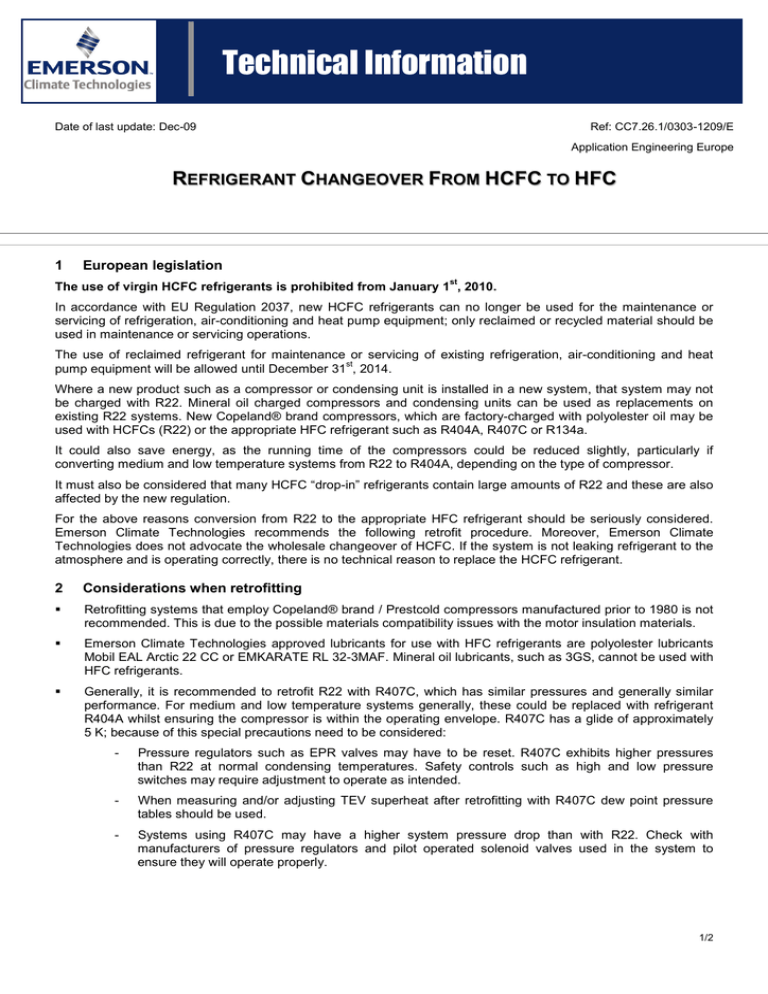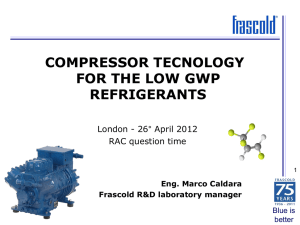Technical Information - Emerson Climate Technologies
advertisement

Technical Information Date of last update: Dec-09 Ref: CC7.26.1/0303-1209/E Application Engineering Europe REFRIGERANT CHANGEOVER FROM HCFC TO HFC 1 European legislation st The use of virgin HCFC refrigerants is prohibited from January 1 , 2010. In accordance with EU Regulation 2037, new HCFC refrigerants can no longer be used for the maintenance or servicing of refrigeration, air-conditioning and heat pump equipment; only reclaimed or recycled material should be used in maintenance or servicing operations. The use of reclaimed refrigerant for maintenance or servicing of existing refrigeration, air-conditioning and heat st pump equipment will be allowed until December 31 , 2014. Where a new product such as a compressor or condensing unit is installed in a new system, that system may not be charged with R22. Mineral oil charged compressors and condensing units can be used as replacements on existing R22 systems. New Copeland® brand compressors, which are factory-charged with polyolester oil may be used with HCFCs (R22) or the appropriate HFC refrigerant such as R404A, R407C or R134a. It could also save energy, as the running time of the compressors could be reduced slightly, particularly if converting medium and low temperature systems from R22 to R404A, depending on the type of compressor. It must also be considered that many HCFC “drop-in” refrigerants contain large amounts of R22 and these are also affected by the new regulation. For the above reasons conversion from R22 to the appropriate HFC refrigerant should be seriously considered. Emerson Climate Technologies recommends the following retrofit procedure. Moreover, Emerson Climate Technologies does not advocate the wholesale changeover of HCFC. If the system is not leaking refrigerant to the atmosphere and is operating correctly, there is no technical reason to replace the HCFC refrigerant. 2 Considerations when retrofitting Retrofitting systems that employ Copeland® brand / Prestcold compressors manufactured prior to 1980 is not recommended. This is due to the possible materials compatibility issues with the motor insulation materials. Emerson Climate Technologies approved lubricants for use with HFC refrigerants are polyolester lubricants Mobil EAL Arctic 22 CC or EMKARATE RL 32-3MAF. Mineral oil lubricants, such as 3GS, cannot be used with HFC refrigerants. Generally, it is recommended to retrofit R22 with R407C, which has similar pressures and generally similar performance. For medium and low temperature systems generally, these could be replaced with refrigerant R404A whilst ensuring the compressor is within the operating envelope. R407C has a glide of approximately 5 K; because of this special precautions need to be considered: - Pressure regulators such as EPR valves may have to be reset. R407C exhibits higher pressures than R22 at normal condensing temperatures. Safety controls such as high and low pressure switches may require adjustment to operate as intended. - When measuring and/or adjusting TEV superheat after retrofitting with R407C dew point pressure tables should be used. - Systems using R407C may have a higher system pressure drop than with R22. Check with manufacturers of pressure regulators and pilot operated solenoid valves used in the system to ensure they will operate properly. 1/2 Technical Information CC7.26.1/0303-1209/E The capacity of the existing R22 thermal expansion valve (TEV) will be approximately the same when using R407C. If R404A or other refrigerants are to be retrofitted a new TEV is recommended and superheat must be checked after operation. Consult with the TEV manufacturer for correct sizing and superheat settings. Filter driers must be changed at the time of conversion with filtration levels conforming to DIN8949 or with an equilibrium point of dryness (EPD) of 50 PPM or lower. Filter driers are important when using HFC refrigerants as these reduce the moisture level within the refrigerant to be between 50 and 120 PPM. Standard evacuation procedures will not reduce the moisture level of the refrigerant to this level. It is advisable to change the sight glass with a new sight glass / moisture indicator, which gives a clear indication of moisture in the system. Polyolester oils are very hygroscopic. They will very quickly absorb moisture from the air once the container is opened. Once the lubricant is added to the compressor it should be quickly sealed. Furthermore, they are generally more abrasive than mineral oils and may pick up additional foreign material in the system and cause damage to the compressor. For this reason, use of a suction filter is recommended. 3 Retrofitting procedure When changing from mineral-based oils to polyolester oils, the maximum permissible residual mineral oil left in the system is 5%. For systems using enhanced surface heat exchangers, excessive mineral oil could affect the heat transfer due to clogging. Therefore, it is desirable to have no more than 1% mineral oil in systems employing these type surfaces. The residual mineral oil can be measured with a refractometer. Before starting the conversion, the system should be thoroughly leak-tested with the HCFC still in the system. All leaks should be repaired before the new refrigerant is added. It is also advisable to check the system operating conditions, particularly the suction and discharge absolute pressures (pressure ratio) and suction superheat at the compressor inlet. Run the compressor for at least half an hour under steady conditions to allow as much oil as possible to return to the compressor. For hermetic compressors including scroll compressors, remove the oil from the compressor and refrigerant from the system. Measure both the oil (litres) from the compressor and the refrigerant removed from the system (kg). For semi-hermetic compressors, it is prudent at this stage just to remove the oil from the compressor crankcase. To obtain an indication of the oil charge in the system, the removed oil should have a similar amount to the compressor factory oil charge, which can be obtained from the nameplate. Run the compressor again with the HCFC refrigerant and polyolester oil, repeating the procedure until less than 5% residual mineral oil is in the system. It is also advisable to carry out an acid test on the lubricant removed from either hermetic or semi-hermetic compressors. Systems that have oil separators, oil reservoirs, oil floats and suction line accumulators must have the oil drained from them. It is advisable that the suction line, liquid line, and evaporator coil be blown clean using regulated dry nitrogen. Add a similar amount of polyolester lubricant to the compressor compared with the amount of oil taken out. Evacuate down to 0.3 mbar/0.22 Torr or lower. Charge with the new refrigerant, which should be approximately 80% of the amount of refrigerant removed from the system. When charging with HFC refrigerants it is advisable to charge with liquid, being careful not to damage the compressor. Start the system and record the operating conditions. Compare operating conditions with the data taken before the change of oil. Irrespective of refrigerant used, the pressure ratio should be similar (discharge pressure / suction pressure, based on absolute pressure measurement). Also, check the colour of the moisture indicator inside the sight glass for moisture content. Re-check the oil, ensuring there is a maximum of 5% residual mineral oil in the system. If it has more than 5% then the oil and refrigerant have to be removed again, until there is less than 5% mineral oil. 2/2

